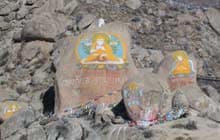
 Jamyang Choje, a disciple of Tsongkhapa, founded Drepung Monastery in 1416. He is reputed to have been born to a wealthy family near the town of Samye and to have secured initial finances for the construction of the monastery from a wealthy childhood friend. Likewise, the immediate popularity of the monastery, which had some 2000 monks in residence within the first two years, is attributed to the support of wealthy family friends.
Jamyang Choje, a disciple of Tsongkhapa, founded Drepung Monastery in 1416. He is reputed to have been born to a wealthy family near the town of Samye and to have secured initial finances for the construction of the monastery from a wealthy childhood friend. Likewise, the immediate popularity of the monastery, which had some 2000 monks in residence within the first two years, is attributed to the support of wealthy family friends.
At its height, Drepung was the world's largest monastery, having over 10,000 monks in residence. In 1530, when the Second Dalai Lama made Ganden Palace his main residence, Drepung monastery became not only the primary residence of the Dalai Lama but also the political base for the Gelug monastic sect. As a result, the tombs of the Second to Fourth Dalai Lamas are at Drepung Monastery. From 1645, when the Fifth Dalai Lama established the Potala Palace as Tibet's political and spiritual headquarters, the bodies of later Dalai Lamas were entombed here instead.
At the time of Drepung's founding, seven tratsangs (or colleges) were instituted, each under the tutelage of one of Jamyang Choje's disciples. In the 18th century, however, the massive student body required the restructuring of the monastery into the current system of four colleges. Each tratsang had its own abbot, syllabus, dormitories, kitchens, etc., with Ngagpa specializing in esoteric teachings and the other three, Loseling, Gomang and Deyang, dedicated to esoteric disciplines. Of these, Loseling was the largest, at one time combining 23 khangtsen (or residences of study).
Drepung Monastery is of great historical importance not only in that it produced some of Tibet's most renowned spiritual leaders, but also in that it always enjoyed significant political influence. This was the case not only when the Dalai Lama ruled from the monastery itself but also afterwards, when the official residence was moved to the Potala Palace. For instance, the abbot of the Tshomchen wielded tremendous power within Lhasa's government.
While the monastery thankfully survived the Cultural Revolution relatively unscathed, more than half of its highest officials fled to India together with the Dalai Lama in 1959. A majority of the Drepung monks remaining in Tibet retired to secular life. As a result, there are now only about 600 monks in residence. Notwithstanding the paucity of its current monastic population, the continued preservation of Drepung's architectural structures make it one of Tibet's most important cultural legacies.